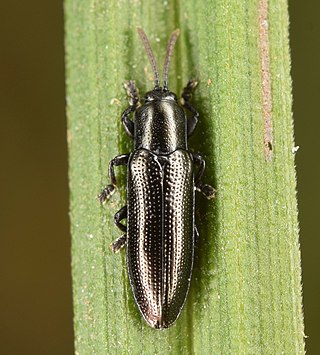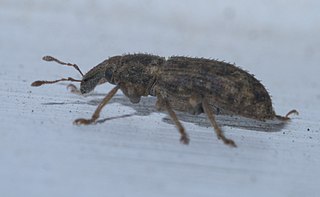Phyllophaga implicita is a species of May beetle or junebug in the family Scarabaeidae.
Neochodaeus is a genus of sand-loving scarab beetles in the family Ochodaeidae. There are at least four described species in Neochodaeus.
Chrysobothris rotundicollis is a species of metallic wood-boring beetle in the family Buprestidae. It is found in North America.
Dubiraphia is a genus of riffle beetles in the family Elmidae. There are about 11 described species in Dubiraphia.

Auletobius is a genus of leaf and bud weevils in the family Attelabidae. There are at least 220 described species in Auletobius.
Photinus curtatus is a species of firefly in the family Lampyridae. It is found in North America.

Stenispa metallica is a species of tortoise beetle or hispine in the family Chrysomelidae. It is found in Central America and North America.
Myochrous magnus is a species of leaf beetle. It is found in Central America and North America. It was first described by the American entomologist Charles Frederic August Schaeffer in 1904.
Laccodytes pumilio is a species of predaceous diving beetle in the family Dytiscidae. It is found in North America.

Listronotus is a genus of underwater weevils in the family Curculionidae. There are at least 100 described species in Listronotus.

Paraclivina bipustulata is a species of ground beetle in the family Carabidae. It is found in the Caribbean, Central America, and North America.
Metachroma suturale is a species of leaf beetle. It is found in the United States, ranging from Arizona to Texas. Its length is between 4.8 and 6.4 mm.
Dialytellus dialytoides is a species of aphodiine dung beetle in the family Scarabaeidae. It is found in North America.
Centrodera decolorata is a species of flower longhorn in the family Cerambycidae. It is found in North America.
Nephus ornatus, the ornate lady beetle, is a species of dusky lady beetle in the family Coccinellidae. It is found in North America.
Pytho seidlitzi is a species of dead log beetle in the family Pythidae. It is found in North America.
Exochomus aethiops, the round black ladybug, is a species of lady beetle in the family Coccinellidae. It is found in Central America and North America.

Limnichidae, commonly called minute marsh-loving beetles, is a family of beetles belonging to Byrrhoidea. There are at least 30 genera and 350 described species in Limnichidae. They are found worldwide, with the greatest diversity in tropical regions. Most species seem to be associated with water-adjacent habitats, such as riparian and coastal locations, though many species are likely fully terrestrial, with some species being associated with leaf litter and arboreal habitats. Species with known diets feed on moss or algae. The oldest fossils of the family are known from mid-Cretaceous Burmese amber from Myanmar.
Dicerca lepida, the embossed hawthorn buprestid, is a species of metallic wood-boring beetle in the family Buprestidae. It is found in North America and varies in size between 13.5mm and 17.5mm.
Haliplus subguttatus is a species of crawling water beetle in the family Haliplidae.




